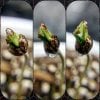im super confused about humus and what is humus vs just compost ...
Allow me to clarify a bit, especially in case any one has the same question ..
When I say humus, I refer to a texture
mostly; one can source this from any HomeDepot during gardening season but I prefer the forest floor as a source.
.. this is more so for those making premium soil on the fly, without the room or time per se to have one's own compost pile ready to go...the humus therefore becomes an important and pivotal factor in making a great medium ready to use. Said humus should be a stable
spongy uniform product whose composition is made up of material that is difficult to identify because it is so decomposed (past tense) that the visible plant and (possibly animal materials) inherent are so broken down that they are no longer easily identifiable to the naked eye.
Our 5-way mix (the simple 1:1:1:1:1 mix mentioned in the posts above) is also usable in a variety of applications, which gives it a cool multi-purpose..
for example, flood and drain/ flush & feed styles, liquid fed organics, and bottled / veganics styles, and even conventional (what some call soup style or chelated salt regimes). So it is very flexible, especially once good humus is involved. It can be a great tool to use for conventional growers switching over to organics, as it can be used in nearly all styles, and therefore one can use just one base to try 2 or 3 styles at once, and learn on the go without risking their entire operation to a succeeding at an all-new way (its almost easier to learn organics without being a conventional grower first, from what I'm noticing, anyway, and this mix helps those who water a bit more aggressively, and are still learning how paramount o2 is in organics, as the drainage is really really great, but at the same time it stays quite moist too)
Humus then, also plays a ph buffering and hormonal role as well- plus it increases water retention, increases CEC and soil texture as well as heightened porosity and plant immunity being other main factors. Compost, especially commercial big box shite,
can lack some of these attributes depending on how it is made, and who is making it, and quality (or lack therefor) of inputs used as well as how far into the decomp'ing it is, and either way,
generally requires the addition of aeration materials to firm up an
ideal texture and ph and so on.
Ideal humus, ime, needs no added aeration or liming agents for example.
Now, with that being said, humus is not better than compost per se.. they have a lot in common, and are some overlaps, but, if one is in a position to make or buy good finished compost, and knows what they are doing, which is awesome, like my boy Greasemonkeyman for example, then all one needs to do really is amend it to spec and aerate it roughly 50/50, depending on overall pore and particle size. This is to me, a bit more like 'advanced organics', although simpler in a way at the same time; it just takes some time, experience/know-how and most importantly, outdoor space to get to this level, really.
That said, I simply provide the people with an alternative method, just so they can progressively build up to that 100% diy stage.. In the latter (diy compost) method, the finer the texture, the higher one can push that 50% aeration mark; for example, when one takes a thermophilic leaf-dominated compost and refines it further by bacterial dominating worms. To me,
nothing is easier than that, taking amended leaf compost and cutting it with 50% aeration (mind you, sourcing a truly premium aeration mix, 6 ingredients or more ideally, as to vary the particle sizes and their effects, becomes the challenge at this point, depending where you are) after letting the worms refine it down in size a bit.
However, equally easy is making our 5 way base, or 1:1:1:1:1 mix, which, according to those I've consulted, performs better than the original mix my first teacher (DP) got us on to, (which was 6:3:3:4, or 25% aeration) as well as the blanket recipe generally given to intro growers, the classic 1:1:1 or 1/3 peat 1/3 castings 1/3 perlite recipe.
I really distaste this recipe for several reasons, for one, perlite is the worst aeration to use, it compacts floats up, and has a cancerous dust, and castings, well if using good quality castings, 15% is more than enough, 20% max. So those 2 flaws alone make me shake my head.
One thing that people will notice, is that making your own
fresh castings, is truly paramount, and its higher in humics and fulvics, not to mention nutrients, cocoons and worms, so much less is needed for peak performance. I believe that the law of diminishing returns comes into play when using it over 20%, one study we found noted an increase in nodal spacing for example, when used above 20%, so morphology can be affected negatively, not to mention how the end product burns. I even know some companies who make castings and they themselves recommend 10-20% of total volume, and they are the ones selling it, so what does that say about the commonly endorsed recipe promoting 1/3 1/3 1/3.. I believe it has flaws and misinforms people, a bit.
Attached is a bit of basic info on humus, for anyone wanting to read a bit more.
Good luck building, folks, if you know where to look all you will have to buy is a couple meals, the rest can be easily found in nature.. everything to grow plants is outside, just look at the forests as an example.. if you have any more questions or comments, fire away!
Have a great day,
DonT











